Take a photo of a barcode or cover
She had no real evidence of anything about Mary and talked more about her father and Henry VIII!
I can only read non fiction/biographies when its about a topic/person I'm very interested in. This has been dubbed the first "official" biography of Lady Mary Carey, also known as Mary Boleyn, the sister of ill fated Queen Anne Boleyn, second wife to Henry VIII. Some things I already knew (such as her notoriousness for being a whore was really just a bunch of hogwash) but many other things I did not know. Well worth the read. I enjoyed how the author expanded on her family's history as well as the histories of her husbands and what futures her children/descendants had, including the daughter likely sired by Henry VIII himself.
Non-fiction isn't for everyone as it comes across as just fact listing and dry history. However Ms Weir makes it come alive while just providing all the appropriate information. So if you like Tudor history or just want to know more about the Boleyn family, this is a must read. Recommended to anyone who is a "fact filer" (enjoy collecting dates/random occurrences/little known facts of history just for fun) like myself.
Non-fiction isn't for everyone as it comes across as just fact listing and dry history. However Ms Weir makes it come alive while just providing all the appropriate information. So if you like Tudor history or just want to know more about the Boleyn family, this is a must read. Recommended to anyone who is a "fact filer" (enjoy collecting dates/random occurrences/little known facts of history just for fun) like myself.
I don’t read all that much historical non fiction and when I do it’s almost always Alison Weir’s work that I read. I essentially thought that the myths regarding Mary Boleyn were true so learning that most of what we know about her is bollocks was enlightening. The problem is that there’s just not enough known about her for sure to make a compelling biography and Alison obviously loves her subject matter too much to fudge the details so it left this book a little spiky and difficult to get a flow going. Nevertheless I did like it and I learnt some new things which is always good.
I should have read the other reviews before I invested so much time in this book. Other comments pretty much hit the nail on the head: There's not much in the record about Mary Boleyn, so there's essentially not much to say about her.
Any book on the Tudors is an automatic tick for me. And if it’s written by Alison Weir - bound to be an automatic read! They’re always so enlightening and well written, so well researched and really well executed. I haven’t met an Alison Weir book yet I haven’t liked!
It was an interesting read and I learnt a lot about Mary Boleyn. She’s somewhat overshadowed by her more famous sister, Anne Boleyn, Queen of England and Henry VIII’s second wife.
I listened to the audiobook on this one but also have the physical book on my shelf as they’re definitely books that I find easy to go back to. You can really tell how much time the author puts into the background research for these books and they seem so thorough and well brought together.
Made up of letters, accounts, historical recordings and what we’ve come to know throughout history, it’s the most comprehensive biography on Mary Boleyn of the time. She’s come to be known as the infamous whore but how truthful and accurate is that? I have to admit to being wrongfully informed on her character myself.
Really great book all in all and glad I finally got round to this one.
It was an interesting read and I learnt a lot about Mary Boleyn. She’s somewhat overshadowed by her more famous sister, Anne Boleyn, Queen of England and Henry VIII’s second wife.
I listened to the audiobook on this one but also have the physical book on my shelf as they’re definitely books that I find easy to go back to. You can really tell how much time the author puts into the background research for these books and they seem so thorough and well brought together.
Made up of letters, accounts, historical recordings and what we’ve come to know throughout history, it’s the most comprehensive biography on Mary Boleyn of the time. She’s come to be known as the infamous whore but how truthful and accurate is that? I have to admit to being wrongfully informed on her character myself.
Really great book all in all and glad I finally got round to this one.
I received a paperback copy of this book through the First Reads program. Weir's "The Six Wives of Henry VIII" is one of my favorite books. I was excited to read "Mary Boleyn", hoping for the same engrossing history lesson. However, this book read more like a dissertation. The reality is there just is not enough information on Mary Boleyn and her life to make a full book. Weir spent most of the book discussing all the hearsay and rumors and then coming up with her rationale for refuting them or agreeing. It was dull and dry and I found I had to force myself to pay attention. I ended up skimming through 75% of the book, picking out the parts that were somewhat interesting. This would have been a great magazine article but just doesn't work in book form.
I have enjoyed reading all of Alison Weir's non-fiction books (I haven't read any of her fiction novels) and "Mary Boleyn: The Mistress of Kings" was no exception. The book is meticulously researched and well-sourced, allowing Weir to go about debunking some of the popular myths and legends about Mary Boleyn, which have been reinforced by decades of popular fiction (and now) television shows.
For those who don't know, Mary Boleyn was the mistress of Henry VIII years before her sister, the unfortunate yet cunning Anne, became the second of his six wives. There are few contemporary accounts of her life, so Weir sets about reconstructing her history based upon the little evidence that is available.
If you're looking for historical fiction... this book isn't it... it's steeped in facts and Weir is quick to back up her assertions with explanations of her evidence -- or admit that certain theories are mere supposition. However, the book is extremely readable and really interesting. While I liked some of her other books even more (The Princes in the Tower and The Six Wives of Henry VIII in particular,) I thought this was also amongst her best.
For those who don't know, Mary Boleyn was the mistress of Henry VIII years before her sister, the unfortunate yet cunning Anne, became the second of his six wives. There are few contemporary accounts of her life, so Weir sets about reconstructing her history based upon the little evidence that is available.
If you're looking for historical fiction... this book isn't it... it's steeped in facts and Weir is quick to back up her assertions with explanations of her evidence -- or admit that certain theories are mere supposition. However, the book is extremely readable and really interesting. While I liked some of her other books even more (The Princes in the Tower and The Six Wives of Henry VIII in particular,) I thought this was also amongst her best.
I really enjoyed this book. The scholarship was flawless and the research well done. I especially enjoyed the introduction as Weir came out against current film and novel portrayals of Mary. The only issue I had was that Mary does come across as insipid, but that is really no fault of Weir's.
emotional
informative
inspiring
reflective
sad
tense
medium-paced
An in-depth look at a marginal but oddly pivotal figure in English history: Mary Boleyn, sister to Anne Boleyn and one-time mistress of the King. Weir's book illustrates the massive gaps we have in history and is an interesting example of history writing as detective work, drawing conclusions from scanty clues. The tone is sometimes a bit too defensive, with hints of esoteric infighting between historians that I'm not privy to.



